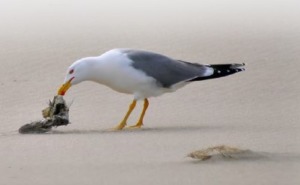This article was published in the journal Ecology and Evolution. [1]

It is now well known that beyond human populations and livestock, antimicrobial resistant bacteria are commonly found in natural ecosystems, particularly in water and wildlife. Urban gulls such as the Yellow-legged Gull are among the opportunistic species that are particularly frequent carriers of these bacteria. In this new study, we aim to understand the spatial and temporal dynamics of the carriage of these bacteria within a colony between hatching and fledging. No spatial pattern is identified but we show that the proportion of individuals carrying antimicrobial resistant bacteria and the diversity of the bacteria carried increase during the season. These results illustrate the complexity of the carriage of antimicrobial resistance in wildlife and the need to take it into account to better understand the dynamics of antimicrobial resistance in ecosystems.
You can access to this article on the publisher’s website [1].
Abstract:
Wild animal species living in anthropogenic areas are commonly carriers of antimicrobial-resistant bacteria (AMRB), but their role in the epidemiology of these bacteria is unclear. Several studies on AMRB in wildlife have been cross-sectional in design and sampled individual animals at only one point in time. To further understand the role of wildlife in maintaining and potentially transmitting these bacteria to humans and livestock, longitudinal studies are needed in which samples are collected from individual animals over multiple time periods. In Europe, free-ranging yellow-legged gulls (Larus michahellis) commonly live in industrialized areas, forage in landfills, and have been found to carry AMRB in their feces. Using bacterial metagenomics and antimicrobial resistance characterization, we investigated the spatial and temporal patterns of AMRB in a nesting colony of yellow-legged gulls from an industrialized area in southern France. We collected 54 cloacal swabs from 31 yellow-legged gull chicks in 20 nests on three dates in 2016. We found that AMRB in chicks increased over time and was not spatially structured within the gull colony. This study highlights the complex occurrence of AMRB in a free-ranging wildlife species and contributes to our understanding of the public health risks and implications associated with ARMB-carrying gulls living in anthropogenic areas.
Bibliographical reference:
Vittecoq M, Brazier L, Elguero E, Bravo IG, Renaud N, Manzano-Marín A, Prugnolle F, Godreuil S, Blanchon T, Roux F, Durand P, Renaud F, Thomas F. Multiresistant Enterobacteriaceae in yellow-legged gull chicks in their first weeks of life. Ecol Evol. 2022 Jun 11;12(6):e8974.